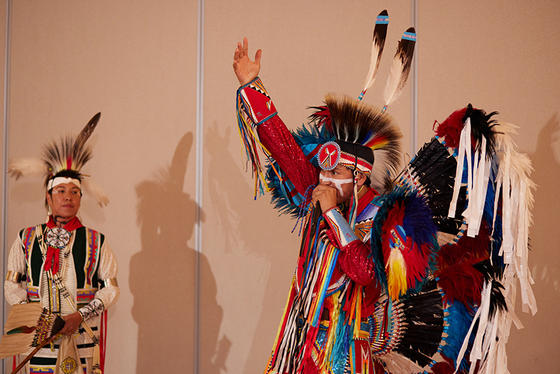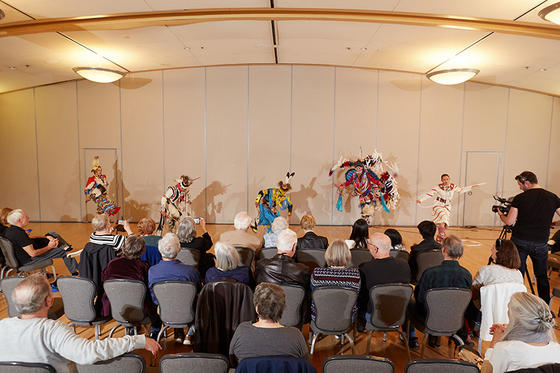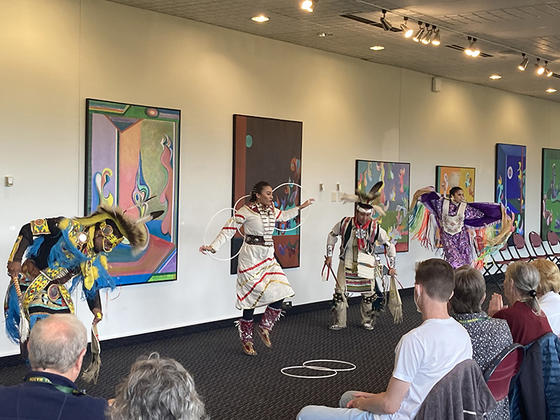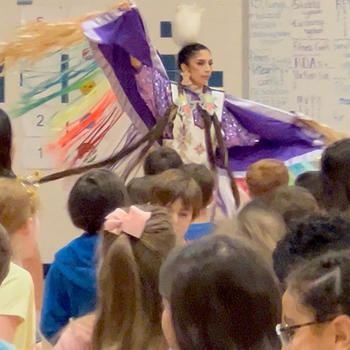In This Story

Culminating the 2022/2023 season at the Center for the Arts at George Mason University, Indigenous Enterprise engaged with George Mason University’s campus as well as the local Fairfax community as a Mason Artist-in-Residence over the course of the last week in April.
Comprised of champion dancers from Native American and Canadian tribes and Nations, this troupe, which recently made history in February 2023 as the first Native American ensemble to participate in the Super Bowl festivities, has also appeared on NBC’s World of Dance and as part of President Biden’s virtual inauguration parade. Proudly sharing their heritage and culture through joyous dance and song, the group is “updating what a Native American dance troupe can be,” as The New York Times notes, rooted in tradition but with hip-hop influences. Indigenous Enterprise’s website reinforces its dedication to “Preservation, Performance, and Progression.” It adds, “We are committed to upholding the legacy of our ancestors while forging a path forward for future generations.”
The residency’s activities commenced with an April 25 lunch with Center for the Arts staff, students and faculty from Mason’s Native American and Indigenous Alliance (NAIA)—including student co-president Domi Hannon, indigenous elder Michael Nephew, and Thomas Wood, Associate Professor of Integrative and Interdisciplinary Studies in the School of Integrative Studies and Director of Environmental Studies on the Piedmont—to welcome members of the Indigenous Enterprise collective: Kenneth Shirley, Navajo Nation; Acosia Red Elk, Umatilla Tribe; Jamaal-Isaac Jones, Navajo Nation; Nanabah Keediniihii, Diné Nation; Quinton Duran, Laguna Pueblo Tribe; and Dezi Tootoosis, Poundmaker Cree Nation.
Indigenous Enterprise founder Kenneth Shirley explained at the welcome luncheon that he considered this residency a homecoming of sorts because the group has roots at George Mason University. While Shirley originates from Arizona, he first formed the ensemble in 2015, collaborating with a friend who was a business student at Mason at the time. “We wanted to share our message in dance, and share the truth with the world,” he told those gathered.
During the event, College of Visual and Performing Arts Programming and Engagement Manager Victor Adebusola presented the members of the ensemble with welcome gifts, including Mason merchandise and honey harvested by Mason’s own The Honey Bee Initiative, a program supported by George Mason University’s School of Business and operated by the Business for a Better World Center.

College of Visual and Performing Arts Director of Programming Adrienne Bryant Godwin notes, “This welcome event was one of the highlights of the residency for me. What I loved about it was that we brought together people from across campus—not only our staff but also students and faculty from the Native American and Indigenous Alliance.”
"It’s something we’ve been wanting to do for a long time,” Godwin continues, “to help build community and introduce our Mason Artists-in-Residence directly to our Center for the Arts staff and people across campus in a fun and casual way. I think everyone really appreciated the opportunity to interact with the artists and enjoy a meal together."
That evening, Indigenous Enterprise led an Artists in Conversation event, co-presented with the City of Fairfax at the Stacy C. Sherwood Community Center. The free presentation, which was hosted by the Friends of the Center for the Arts, featured the artists demonstrating and discussing their dances—including the Jingle Dance, Southern Straight Dance, Grass Dance, Men’s Fancy Dance, Hoop Dance, and Women’s Fancy Shawl Dance—as well as regalia.

The artists explained that the beautiful clothes they wear while performing should not be considered costumes, but rather regalia. “These are not costumes, something we are pretending to be. This is who we are,” said hoop dancer Nanabah Keediniihii. Acosia Red Elk pointed out that she wears heirloom dresses, items passed down from her grandmother. “This is living history,” she continues, noting that her sleeve’s fringe had been specifically kept short, so that the women gatherers of the Pacific Northwest’s Umatilla could wear it while foraging on the plateau. Dezi Tootoosi explained the significance of the beadwork feather on her shawl, representing “White Feather,” her Cree name. Quinton Duran showed the pueblo pottery designs of his Laguna Pueblo tribe, woven into the design. Jamaal-Isaac Jones pointed out the Porcupine quills sewn into his Navajo regalia, noting how the Grass dance he performs was meant to bless the grounds, to stamp down the long prairie grasses for ceremonies. “I dance for my ancestors,” he said, “and for those who cannot dance.”
A community member attendee Sherri Shunfenthal was so moved by the event, she composed a poem inspired by the experience. An excerpt is included below with her permission:
are sacred
so is preparation for the dance
each piece of clothing has been
stitched with deep regard that shapes the future
we dress slowly with care
our outfits not a costume
more like our dancing skin.
On April 26, Indigenous Enterprise joined Dewberry School of Music Professor Gregory Robinson’s “Music History in Society” class. The highly interactive event engaged class members in movement, with attendees participating alongside the artists.

Then that afternoon, the troupe led a lecture/demonstration for members of the Osher Lifelong Learning Institute (OLLI). After performing in tandem with other troupe members, Nanabah Keediniihii of the Dine Nation recounted for the class how as a young girl, she was inspired to become part of the hoop dancing tradition—typically male-dominated—by watching female hoop dancer Jasmine Pickner-Bell on YouTube. She described how the hoops can be made of willow bark or wood, and that after the dance were traditionally burned in the fire, with prayers rising up alongside the smoke to the Creator. She explained that the dance takes place from the point of view of a willow tree, replicating the things a tree might see from their perspective: a snake, caterpillar, butterfly, eagle, flowers—even Mother Earth.

The discussion also explored the generational trauma caused by colonialism, including the boarding schools founded to separate American Indian children from their families. Shirley described how his grandfather, after whom he was named, had been beaten by a teacher in boarding school in the 1940s for speaking his native language. Acosia Red Elk spoke of “the void it caused in the culture” as the number of language-speakers dwindled, and regalia was buried underground to protect it from being confiscated. She spoke hopefully of “the resurgence” of these traditions which Indigenous Enterprise aims to foster. “We’re building bridges like this,” she said, gesturing to the audience.

Acosia Red Elk encouraged everyone attending to explore and honor their own heritage. She observed that no matter their background, when all people hear the beating of the drum, “Your spirit remembers. All of us do have indigenous roots. That doesn’t mean you’re Native American. But find out where your lineage is, what your spiritual connection is. Your spirit remembers something.”

In addition to residency events with adults, Indigenous Enterprise spent time with Fairfax County Public Schools’ kindergarten, first-, and second-grade classes at Laurel Ridge Elementary School—age groups that have been studying Native American history. In the school’s gymnasium, the troupe held up a map to pinpoint where their respective tribes originated and got approximately 150 students and teachers up and dancing to the beat. College of Visual and Performing Arts Programming and Engagement Manager Victor Adebusola notes, “I smiled for like an hour straight. The event was incredibly well-received by the Laurel Ridge students. They were on their feet, having the best time.” Acosia Red Elk dubbed it one of the best audiences the troupe ever had. Watch a brief video clip.
Back at George Mason University before their culminating performance on Saturday, April 29 at the Center for the Arts, Indigenous Enterprise troupe members joined local Indigenous Elder Michael Nephew in a pre-performance discussion in Monson Grand Tier. Then to open the performance, titled Indigenous Liberation, in the Concert Hall, Dennis Zotigh, a writer and cultural specialist at the Smithsonian's National Museum of the American Indian in Washington, D.C. and a Kiowa/Ohkay Owingeh Pueblo/Isante Dakota Indian, gave a land acknowledgment from the stage.

Acknowledging the land George Mason University occupies and its Potomac River life sources, Zotigh honored the Doeg ancestors and the recognized Virginia tribes who have stewarded these lands for millennia, including the Rappahannock, Pamunkey, Upper Mattaponi, Chickahominy, Eastern Chickahominy, Nansemond, Monacan, Mattaponi, Patawomeck, and Nottaway—past, present, and future—and the Piscataway tribes from both sides of the Potomac.
The evening’s approximately 60-minute program, was a joyful celebration of what lies at the heart of these powerful traditions—weaving virtuosic dance showcases with interstitial videos explaining the origin stories of the dances, and even including a raucous dance-off. Immediately following the performance, the artists reappeared on stage to participate in a discussion with the audience, moderated by Center for the Arts Director of Programming Adrienne Bryant Godwin.
Read more about the Center for the Arts Mason Artist-in-Residence program, including the three visiting artists just announced as part of the upcoming 2023/2024 season: Silkroad Ensemble (for the second in their three-year residency), A.I.M by Kyle Abraham, and Small Island Big Song.
"Indigenous Liberation" was made possible by the New England Foundation for the Arts’ National Dance Project, with lead funding from the Doris Duke Charitable Foundation and the Andrew W. Mellon Foundation.
